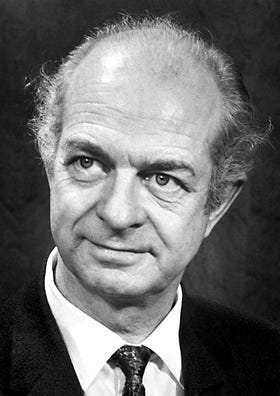# The Genius and Enigma of Linus Pauling: Chemistry's Dual Legacy
Written on
Chapter 1: Introduction to Linus Pauling
Linus Pauling, often regarded as the father of modern chemistry, is a two-time Nobel laureate whose contributions to the field are monumental. However, he is equally known for promoting the myth surrounding vitamin C.
To begin, consider what you typically reach for when a cold strikes. While no remedy outright cures the common cold, many opt for cough syrups or decongestants to alleviate symptoms. A widespread belief, however, suggests that consuming high doses of vitamin C can expedite recovery. Many of us were raised with the notion that drinking orange juice during a cold enhances immune function due to its vitamin C content. Interestingly, red pepper juice actually contains more vitamin C per unit volume than orange juice.
Despite this belief, scientific evidence does not support the idea that excessive vitamin C intake hastens recovery from colds. Your body regulates its vitamin C levels carefully, with a maximum absorption capacity typically between 200-400 milligrams (mg). Therefore, when you consume those high-dose vitamin C packets, your body excretes the excess, rendering those 1000 mg doses largely ineffective. While vitamin C is essential for immune function, overconsumption does not equate to faster recovery.
But how did this widespread misconception originate? The roots of this belief lie in the unverified expansion of expertise into areas outside one's domain. Today, we will delve into Pauling’s significant contributions to chemistry, as well as clarify the vitamin C conundrum.
Chapter 2: The Evolution of Chemistry (1900-1925)
The period from 1900 to approximately 1925 was a transformative era in chemistry, marked by numerous groundbreaking developments. Not to downplay their significance, but the sheer volume of important discoveries during this time was staggering. Previous discussions have highlighted Gil Lewis's advancements in chemical structure, Bohr's quantum mechanical model of the atom, and Sir J.J. Thomson's electron experiments.
The quest for understanding chemical bonding began with Lewis, whose empirical findings laid the groundwork for mathematical modeling. In 1927, Walter Heitler and Fritz London utilized the Schrodinger Equation to formulate a mathematical representation of the diatomic hydrogen molecule. While the original mathematical paper may be complex, it underscores the universal language of mathematics.
This pursuit of knowledge regarding chemical bonds set the stage for Linus Pauling, the only individual to receive Nobel Prizes in both Chemistry and Peace. His seminal work, "The Nature of the Chemical Bond," published in four parts in the Journal of the American Chemical Society, synthesized the efforts of Heitler, London, and Lewis. Pauling's contributions fundamentally shaped our understanding of chemical bonding and advanced the field of chemistry significantly.

Chapter 3: The Paradox of Pauling’s Legacy
Through his research, Pauling introduced concepts such as electronegativity, hydrogen bonding, and hybridization, which form the foundation of modern chemistry education. The tetrahedral structure of carbon and numerous bond lengths and angles were derived from his work, merging empirical data with theoretical frameworks.
However, as Pauling aged, he became increasingly fixated on vitamin C, claiming it could cure various ailments, including cancer and the common cold. This obsession led to the establishment of an institute dedicated to researching high-dose vitamin C, further solidifying his controversial stance.
This situation exemplifies the dangers of an expert overreaching into unrelated fields, particularly when they refuse to adapt or retract their claims in the face of contrary evidence. While Pauling's scientific achievements remain significant, this later phase of his career has complicated his legacy, transforming him from a revered scientist to a controversial figure.
Chapter 4: Conclusion: A Complex Legacy
Despite his later eccentricities, Pauling’s contributions to chemistry solidify his place among the greats. His groundbreaking research ushered in a new era of understanding, blending theory with empirical evidence in ways that have yet to be matched. Today, we recognize Linus Pauling not only for his brilliant scientific mind but also for the complexities of his later beliefs. Through this exploration, he is no longer the most brilliant and eccentric individual you've never heard of.
Works Consulted:
Brock, William H. The Chemical Tree: A History of Chemistry. New York: Norton and Co, 2000.
Ihde, Aaron J. The Development of Modern Chemistry. New York: Dover Publications, 1984.
Pauling, Linus. “The Nature of the Chemical Bond.” Journal of the American Chemical Society, 1931, 53, 1367.